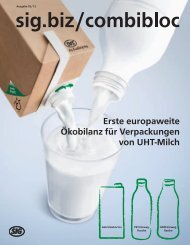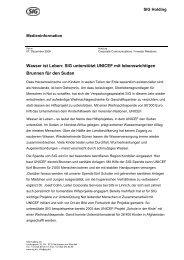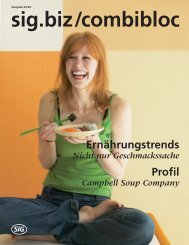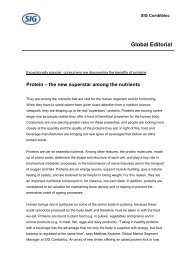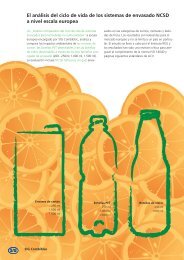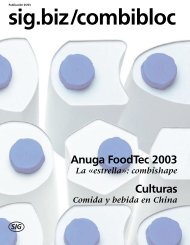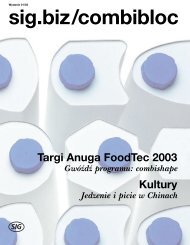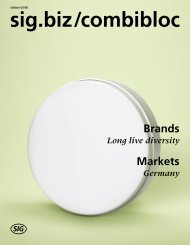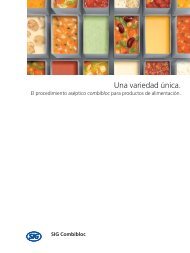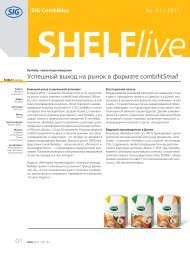Create successful ePaper yourself
Turn your PDF publications into a flip-book with our unique Google optimized e-Paper software.
Portrait<br />
1887 1909 1914 1917 1919 1924 1928 1937 1943 1946 1947<br />
A brand undergoes change: the 100 year history of Maggi seasoning.<br />
<strong>sig</strong>.<strong>biz</strong>/<strong>combibloc</strong> 03/03<br />
success, the product was not a great marketing<br />
achievement. Imperturbed, Julius<br />
Maggi continued to look for a way of producing<br />
powdered soup that could be used<br />
to cook “fast food”. Finally, in 1886, he<br />
added to his range of products the first<br />
ready-to-cook soups made of pea and<br />
bean flour. These gradually took over<br />
from the legume flour.<br />
The first brand product in the world<br />
In the same year, he launched the<br />
legendary Maggi seasoning sauce in its<br />
striking brown bottle with a long neck and<br />
yellow label. This product became so popular<br />
that the herb lovage, which has a similar<br />
taste, soon became widely known as<br />
“Maggi-Kraut” (Maggi herb). Maggi seasoning<br />
is considered to be the first real brand<br />
product in the world. The original recipe<br />
from 1886 is still kept under lock and key,<br />
like that for American Coca-Cola. What is<br />
known is that the brown seasoning is made<br />
of water, wheat and soya protein, salt, yeast<br />
extract and flavourings. However, nobody<br />
has yet succeeded in copying the product<br />
exactly. This seasoning has held its market<br />
position unchallenged for more than 100<br />
years. Some 9,000 tonnes of it are still produced<br />
every year.<br />
Maggi seasoning was soon followed by<br />
stock in capsule or cube form, which went<br />
onto the market at the turn of the century.<br />
More and more new products with improved<br />
formulas and in different forms were<br />
developed. In 1893, the factory was complemented<br />
with its own farm business, so that a<br />
supply of fresh vegetables and other produce<br />
was guaranteed.<br />
The young entrepreneur proved his<br />
far<strong>sig</strong>htedness by extending his company<br />
across the borders of Switzerland. As early<br />
on as 1887–89, Maggi set up branches<br />
in Singen, Berlin, Amsterdam, Bregenz,<br />
Vienna, Paris, Milan, Prague, Posen, London<br />
and New York. This expansion strategy<br />
made a <strong>sig</strong>nificant contribution towards<br />
making Maggi and his products popular all<br />
over the world. To acquire the capital he<br />
needed for this expansion, in 1889 he<br />
transformed the limited partnership company<br />
he had set up three years previously<br />
into a public limited company called the<br />
“Factory for Maggi foods in Kempttal”.<br />
Poetic licence<br />
Maggi realised early on that capital and<br />
good products alone would not guarantee<br />
him business success. The retail trade and<br />
consumers must be informed about new<br />
products and convinced of their quality. At<br />
the beginning, Maggi wrote and de<strong>sig</strong>ned all<br />
the advertising himself. But very soon his<br />
enormous work load allowed him too little<br />
time for this job. For this reason, in 1886, he<br />
set up his own “advertising and press office”.<br />
The first head of this office, Franz<br />
Wedekind, who later became a famous playwright,<br />
spiced up the early Maggi advertisements<br />
with his own original texts: “Poetry is




